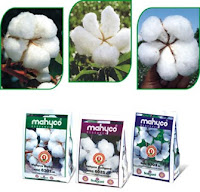- By Deepa Krishnan
I was in the Marathwada region a couple of weeks ago, on a trip to the Ajanta Caves. As you probably know, this area of Maharashtra has been suffering from drought for the last 2 years. So I was really delighted to see that it had been raining! Everywhere we could see farmers ploughing the moist soil with bullocks.
 |
| Beautiful pair of oxen, rich moist soil |
The soil was a kind of clayey black (although it looks brownish when freshly tilled). It is very fertile black soil, said to be perfect for cotton.
Most of the farms we saw were small and seemed to be self-cultivated. I was curious about it, so I looked up the
Aurangabad Gazette, and found that more than 75% of the farmers cultivate their own land, with the help of family, or by hiring someone to work alongside them. The farmer we saw was working with one helper.
 |
| Sowing seeds. When I asked what they were sowing, I found that it was maize. |
The farmer's little daughter was playing in the field, running around, and poking the soil. She seemed very absorbed in her game, I wonder what she found :)
 |
| Ploughed field with seed bag and sowing vessel, and little kid running around the field |
The plough the farmer was using was the standard one-point model, the kind that leaves a single deep furrow. The farmer can carry this kind of plough on his shoulder to work every morning and take it back at night. We did not see a single tractor anywhere, although we drove around for about 2 hours. Maybe it was too early in the planting season for tractors.
 |
| The plough has a handle to hold and direct it. |
Currently, the kharif crop is being planted. These crops start coming to the market in autumn (harvest goes on from Sep to Dec). In case you didn't know, the word kharif means autumn in Urdu.
The kharif food crops in this region are wheat, jowar (sorghum/white millet), bajra (pearl millet), maize, green gram, black gram, pigeon peas, and soybean. Jowar and bajra are important food crops, and they are used not only by the farmer's family, but also for providing fodder to livestock. The most important cash crops (grown only for sale, not for own consumption) in this area are cotton and sugarcane.
Cotton is primarily sown in the rainy season, and harvested in Sep-Oct.

In 2006, many farmers in this area began experimenting with Monsanto's BT Cotton,
hoping this would increase yields, but this experiment failed for several reasons: high price of the seeds, poor understanding of the crop's requirements (it is unsuitable for areas with poor rainfall or poor irrigation facilities), high price of pesticides and to top it all, drought. The last two years have been terrible. Farmers who planted multiple types of crops, especially grains and pulses with shorter harvesting cycles, have fared better than those who relied only on cotton.
The government is now looking at a desi solution to the problem, using non-BT seed varieties suggested by Centre for Indian Cotton Research (CICR). Will it work? Trials only started in last year's kharif season, and it is too soon to tell.
Apart from cotton, the other big crop in this area (and indeed, all of Maharashtra) is sugarcane. There are multiple seasons for planting sugarcane - adsali is planted in the rains, pre-seasonal sugarcane is planted in Oct-Nov, and the suru crop is planted in Jan-Feb. In addition, there is also a ratoon crop, where the farmers use the stubble from the previous crop to grow the next crop.
Sugarcane is entirely the wrong crop for Marathwada, given the high amount of water it needs. But farmers are attracted to sugarcane because it fetches more money compared to other crops that they can grow on the same field. Also, the presence of a political sugar lobby ensures that it is easier to demand a better
Minimum Support Price for sugarcane.
 |
| Farm with square structure in foreground, I assume for holding water. |
The Marathwada area is also well known for its citrus fruit crop. The farm that we saw had rows of trees, I presume at least some of them were "mosambi" that the region is famous for.
 |
Can you figure out what these fruit trees are?
Please leave a comment if you know the name. |
I hope this is rainy season turns out to be good for Marathwada. Please join me in wishing these farmers a great harvest and joyful days ahead. May they leave these terrible years behind them,
 |
| Our tea break overlooking a farm, Aurangabad - Ajanta road |


























